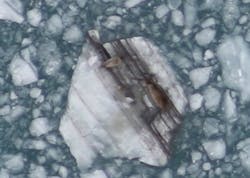Infrared imaging captures seals on ice
As part of a harbor seal population study, researchers in the Polar Ecosystems Program at the National Marine Mammal Laboratory (part of the National Oceanic and Atmospheric Administration) tested an aerial infrared imaging system at two glaciers in Alaska. The researchers believe that a reliable thermal method would increase the efficiency and accuracy of image analysis of seals on ice and help them determine the most effective survey altitude.
Working with system integrator MoviMED (Irvine, CA, USA), the researchers developed an imaging system comprising an A325 IR camera from FLIR Systems (Wilsonville, OR, USA), a Canon EOS 1Ds Mark III camera, and a custom computer, all mounted in the belly port of a Twin Otter aircraft. The thermal and visible cameras shot through small, open air ports and were aligned to have overlapping footprints. The threshold between seals and background temperatures was determined using ImageJ, which is a public-domain, Java-based image-processing program developed at the National Institutes of Health. Accurate auto-counting was restricted because of limited camera resolution; however, reliable thermal triggering of image collection could be achieved at 1200 ft altitude with the 320 × 240-pixel thermal imager.
Posted by Vision Systems Design


